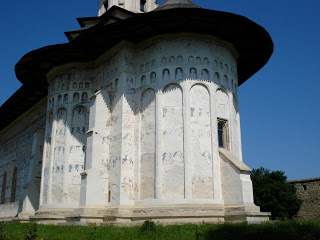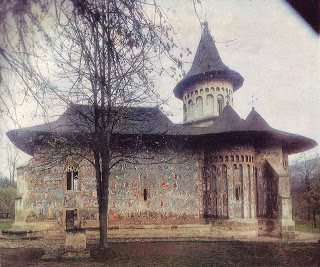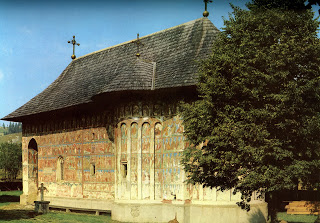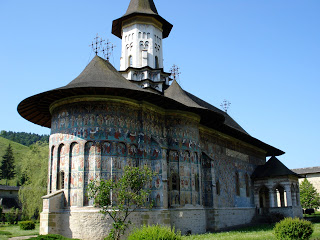Medieval History
My good friend Mollie Craig has kindly responded to the interview questions, posted below. I bet you didn't know there were Romanian medieval churches with exterior frescoes, did you? Mollie approaches Art History with an open mind and always has insightful ideas, and has brought the beauty of Romanian churches to light!



 1. What was your thesis topic?
1. What was your thesis topic?
2. What draws you to medieval art?
3. What do you wish the general public knew about your area of expertise?
4. Do you have any favorite online art of historical resources?
5. Your favorite (if you can pick one) artwork from the Middle Ages.
6. What area of study in medieval art history do you find the most intriguing?
7. In your travels, do you have a specific place that you felt the most 'in touch' with the Middle Ages?
- Interviews, Part Iv
My dear friend Rachel was good enough to interview for this blog, and here are her responses! She has an MA in Art History, and wrote her thesis on Jordanian mosaics featuring the Messianic Age motif. She's a fantastic scholar, thorough and well-thought,...
- Interviews, Part Ii
As part of my interviews for this blog, I asked my friend Elliott who is currently working on his doctorate. When it comes to medieval art (or art history in general) I don't think I've met anyone with a greater passion. As you will see, he is...
- The Route Of Medieval Churches In Szatmár County
Csengersima, parish church A major research project, aimed at surveying and documenting the churches of medieval Szatmár country, was completed last week, and its results are now largely available on the web. As the territory of medieval Szatmár...
- Virtual Visits To Transylvanian Medieval Churches
Gelence (Ghelinta) A new website provides a number of very-well done virtual visits (360° panoramas) to Transylvanian sites. The site, called Treasures of Szeklerland introduces monuments and sites from the eastern part of Transylvania, the territory...
- Sanctuary Fittings And Something Rare
As well as the original pavement the chancel of Laxton church in Nottingham is lucky enough to still retain its stone sanctuary furnishings, fourteenth century piscina with double drains, Easter sepulchre, sedilia and image corbels. ...
Medieval History
Interviews, Part III
My good friend Mollie Craig has kindly responded to the interview questions, posted below. I bet you didn't know there were Romanian medieval churches with exterior frescoes, did you? Mollie approaches Art History with an open mind and always has insightful ideas, and has brought the beauty of Romanian churches to light!


My topic was the Painted Monasteries of Romania, which were built in the early sixteenth century. I explained why the monasteries were painted not only on the inside but also on the outside. The frescoes on the outside outline different celebrations during the weeks of Lent. I connect each image to a day of Lent and the theology of that time. I then wrote about how the Romanians followed Byzantine tradition during Easter and paraded around the outside of the churches. During this parade, the frescoes on the outside would take on more meaning, reminding the people of Lent and the commitments they made during their 40ty day fast. Easter was the most important celebration for Romanians during the medieval period and their churches reflected that on the outside through their frescoes.
2. What draws you to medieval art?
I love the medieval period in general because of how devoted the culture was. The art during this period is mostly religious works and points towards Christ. They had a deep love and respect for Jesus Christ and it shines through their artwork. I also love the style and lines used in the artwork. Many people think that it is elementary and shows how unenlightened the people of the medieval period were, but I love the simplicity and drama. I remember Mark Johnson once told me that maybe the people knew how to draw perspective but chose not to just like Picasso did at the beginning of the twentieth century. That made me look at the meaning and symbolism in all aspects of medieval art and it made me love it even more and see that it is not so elementary as many believe.
Well considering my area is Romanian medieval art, I wish people knew that medieval art is not only in France and England - that people everywhere at that time had beautiful art and architecture. Romanian medieval art and churches are just as fascinating as those found in Western Europe. I wish that the general public knew that the Painted Monasteries of Romania exist. These monasteries are unique because of the painting on the inside and outside of the buildings. The images on the outside reflect the culture and beliefs of Romanians during the medieval period. They show how dedicated these people were to Christ and, according to my research, how dedicated they were to the celebration of Lent and Easter.
I love JSTOR. The articles on that website are so helpful and their search tools are easy to navigate through.
This is hard and I can't pick one. I love architecture as is apparent with my monasteries. I love Chartres Cathedral in France and Salisbury Cathedral in England. I also wish I could see the Monastery of St Gall according to the famous plan. I love how people who do not understand the history of medieval architecture say that the churches are dark and depressing not knowing how light and heavenly the buildings of the medieval period truly are.
The area of medieval art history I find most intriguing is feminist art. I find it so intriguing because I haven't studied it as much as I would like. I wrote a paper comparing Eve and Mary and would love to dive into that more and see other examples of how women let their voice be heard during a time when they really didn't have a voice.
Romania in general has that feeling especially when you get into the back country. When I visited the Painted Monasteries and was the only person around, it took me back to the time when they were built and the painted stories on the façade would have been bright and fresh.
- Interviews, Part Iv
My dear friend Rachel was good enough to interview for this blog, and here are her responses! She has an MA in Art History, and wrote her thesis on Jordanian mosaics featuring the Messianic Age motif. She's a fantastic scholar, thorough and well-thought,...
- Interviews, Part Ii
As part of my interviews for this blog, I asked my friend Elliott who is currently working on his doctorate. When it comes to medieval art (or art history in general) I don't think I've met anyone with a greater passion. As you will see, he is...
- The Route Of Medieval Churches In Szatmár County
Csengersima, parish church A major research project, aimed at surveying and documenting the churches of medieval Szatmár country, was completed last week, and its results are now largely available on the web. As the territory of medieval Szatmár...
- Virtual Visits To Transylvanian Medieval Churches
Gelence (Ghelinta) A new website provides a number of very-well done virtual visits (360° panoramas) to Transylvanian sites. The site, called Treasures of Szeklerland introduces monuments and sites from the eastern part of Transylvania, the territory...
- Sanctuary Fittings And Something Rare
As well as the original pavement the chancel of Laxton church in Nottingham is lucky enough to still retain its stone sanctuary furnishings, fourteenth century piscina with double drains, Easter sepulchre, sedilia and image corbels. ...
